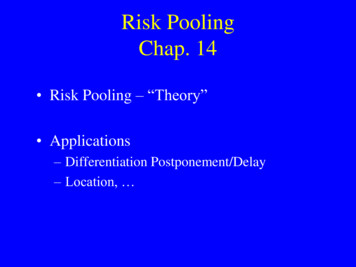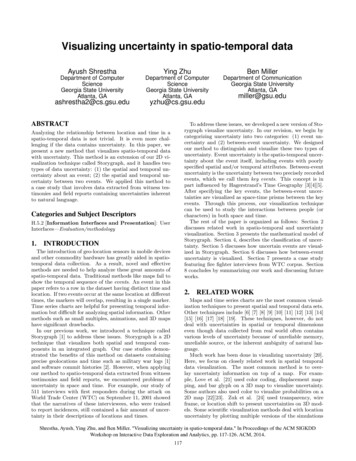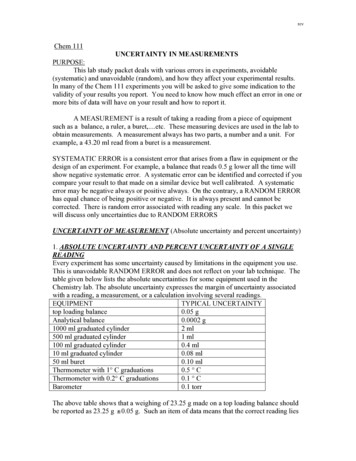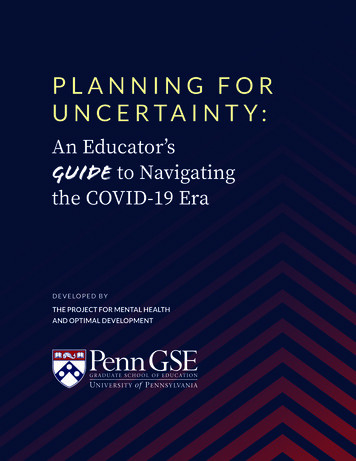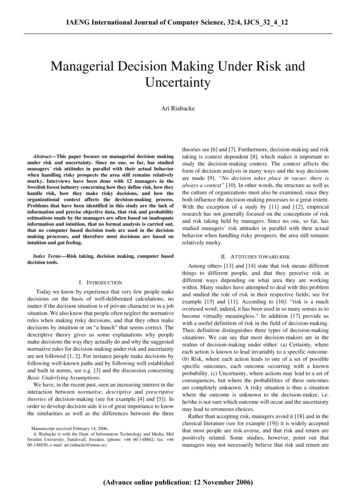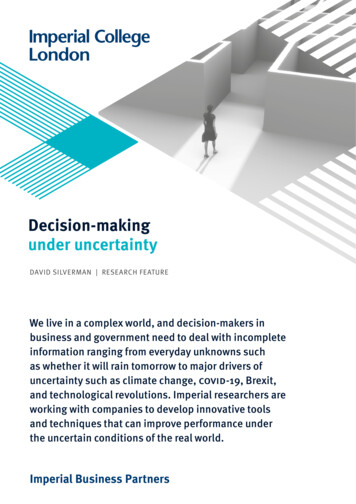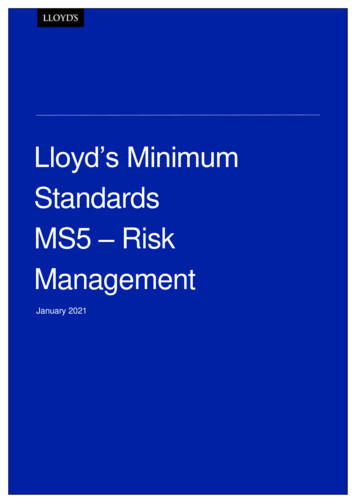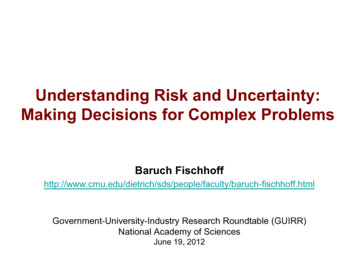
Transcription
Understanding Risk and Uncertainty:Making Decisions for Complex ProblemsBaruch ndustry Research Roundtable (GUIRR)National Academy of SciencesJune 19, 2012
How Do You StudyDecision Making Under Uncertainty?
Decision Science:Integrated Study ofHow people should make decisions(normative analysis)How people do make decisions(descriptive research)How to help people make better decisions(prescriptive interventions)
A non-disciplinary field,with contributions ns researchneurosciencepolitical science
Intellectual RootsRamsey/von Neumann & Morgensternutility theoryRaiffa/Edwardsdecision analysisSimon/March/Cyertbounded rationalityTversky & Kahnemanheuristics and biasesprospect theory
Some of Our Colleagues’ Books
Some of Our Books
Some on Intelligence Analysis
Some Results
Decision Science Finds ThatDecision making follows simple principles.
Some Principles of JudgmentPeople are good at tracking what they see,but not at detecting sample bias.People have difficulty projecting nonlinear trends.People have limited ability to evaluate theextent of their own knowledge.People have difficulty imagining themselvesin other visceral states.Transient emotions can affect perceptions,perhaps enough to tip close decisions.
Some Principles of ChoicePeople consider the return on theirinvestment in making decisions.People dislike uncertainty.People confuse ignorance and stupidity.People are insensitive to opportunity costs.People are prisoners to sunk costs, hatingto recognize losses.People may not know what they want,especially with novel questions.
Decision Science Finds ThatDecision making follows simple principles.
Decision Science Finds ThatDecision making follows simple principles.However,the set of principles is large,the contextual triggers are subtle, andthe interactions are complexAs a result, decision-specific research isneeded.
Decision Scienceas an Engineering ScienceApplying basic analytical and behavioralprinciples, in conjunction with subjectmatter expertise, to problem solving andsystems design.
With the Applications Essentialto Scientific ProgressApplied basic sciencedo we have predictions?are they accurate?Basic applied scienceare we seeing something new?can we domesticate it for basicresearch?Alan Baddeley
Some of Our ApplicationsplagueperchloroethyleneLNGclimate changedetergentbreast cancernuclear explosionsherpes (stigma)xenotransplantationsmart metersdomestic radonmethylene chlorideEMFUXOviolent radicalizationbreast implantsnuclear power in spacePlan B (morning after pill)neonatesvaccines (anthrax, MMR)
Some Typical Projects
Carotid EndarterechtomyProblem: medical informed consentNormative: value-of-information analysis forability of risk facts to affect patientdecisionsDescriptive: [no trustworthy knowledge]Prescriptive: focus on probabilities of death,stroke, and facial paralysis; onmeaning of paralysisMerz, J., Fischhoff, B., Mazur, D.J., & Fischbeck, P.S. (1993). Decision-analytic approach to developingstandards of disclosure for medical informed consent. Journal of Toxics and Liability, 15, 191-215
Paint StripperProblem: chemical labeling standardsNormative: diffusion-uptake model, predictingcumulative dose and peak levelsDescriptive: users willing to act, but confusedover method effectivenessPrescriptive: voluntary control perhapsimpossible, without mandatory label designRiley, D.M., Fischhoff, B., Small, M., & Fischbeck, P. (2001). Evaluating the effectiveness ofrisk-reduction strategies for consumer chemical products. Risk Analysis, 21, 357-369
Sexual AssaultProblem: confident, universal, contradictoryadviceNormative: meta-analysis of effectivenessstudiesDescriptive: nuanced belief structure, differinggoals, exaggerated effectivenessPrescriptive: realistic expectations, societalresponsibility, effectiveness researchFischhoff, B. (1992). Giving advice: Decision theory perspectives on sexual assault. AmericanPsychologist, 47, 577-58
CryptosporidiumProblem: emergency warning systemNormative: model of system performance,including detection, coordination, andconsumer behaviorDescriptive: little knowledge in affectedcommunities, useless knowledge amongvulnerable individualsPrescriptive: abandon warning system, provideservices for vulnerableCasman, E., Fischhoff, B., Palmgren, C., Small, M., & Wu, F. (2000). Integrated riskmodel of a drinking waterborne Cryptosporidiosis outbreak. Risk Analysis, 20, 493-509
Getting Organized
Recommendations forManaging Emerging EventsHave a consistent policy in all domainsProvide useful, timely informationAddress: risks and benefits, uncertainty,personal actions, FDA actionsAudience needs should drive agencyanalysesUse standard formats; evaluate routinelyConsider needs of diverse pg.html
ports/ucm268078.htm
Decision Science in Intelligence AnalysisConsensus ReportAnalysis, Recommendations,& Immediate Actions (100pages)Collection of PapersIntroduction to Methodsand Evidentiary Base(350 pages)Intelligence Analysis for Tomorrow: http://www.nap.edu/catalog.php?record id 13040Intelligence Analysis: Behavioral and Social Scientific Foundations:http://www.nap.edu/catalog.php?record id 13062
a/upcoming-colloquia/science-communication.html
Applications RequireDomain specialistsRisk and decision analystsBehavioral scientistsPolicy/system analysts31
Decision Science Resource CentersProvide publication-quality scientific supportfor designing, implementing, and empiricallyevaluating solutions.32
Decision Science Resource CentersProvide publication-quality scientific supportfor designing, implementing, and empiricallyevaluating solutions.-- quality assurance-- economies of scope-- pool lessons learned-- anticipate problems-- involve academic researchers33
BooksAriely, D. (2008). Predictably irrational. New York: Harper Collins.Bazerman, M.H., & Watkins, H.D. (2004). Predictable surprises. Boston: Harvard Business School.Fischhoff, B. (2011). Judgment and decision making. London: Earthscan.Fischhoff, B. (2011). Risk analysis and behavioral research. London: Earthscan.Fischhoff, B., Brewer, N., & Downs, J.S. (eds.). (2011). Communicating risks and benefits: An evidence-based user’sguide. Washington, DC: Food and Drug Administration.Fischhoff, B., & Chauvin, C. (eds.). (2011). Intelligence analysis: Behavioral and social science foundations.Washington, DC: National Academy Press.Fischhoff, B., & Kadvany, J. (2011). Risk: A very short introduction. Oxford: Oxford University Press.Fischhoff, B., Lichtenstein, S., Slovic, P., Derby, S. L. & Keeney, R. L. (1981). Acceptable risk. New York: CambridgeUniversity Press.Hammond, J.S., Keeney, R., & Raiffa, R. (1998). Smart choices. Boston: Harvard Business School.Heuer, R. (1999). Psychology of intelligence analysis. CIA: Center for Intelligence Analysis.Kahneman, D. (2011). Thinking fast and slow. New York: Farrar Straus & Giroux.Kahneman, D., Slovic, P., & A. Tversky, A. (Eds.). Judgment under uncertainty: Heuristics and biases (pp. 422-444).New York: Cambridge University Press.Morgan, M.G., Fischhoff, B., Bostrom, A., & Atman, C. (2001). Risk communication: The mental models approach. NewYork: Cambridge University Press.Morgan, M.G., & Henrion, M. (1990). Uncertainty. New York: Cambridge University Press.National Research Council. (2011). Intelligence analysis for tomorrow. Washington, DC: National Academy Press.Raiffa, H. (1968). Decision analysis. Reading, MA: Addison-Wesley.Tetlock, P. (2005). Expert political judgment. Princeton: Princeton University Press.Research ArticlesBruine de Bruin, W., Parker, A., & Fischhoff, B. (2007) Individual differences in adult decision-making competence (ADMC). Journal of Personality and Social Psychology. 92, 938-956.Fischhoff, B. (1992). Giving advice: Decision theory perspectives on sexual assault. American Psychologist, 47,577-588.Fischhoff, B., Atran, S., & Fischhoff, N. (2007). Counting casualties: A framework for respectful, useful records. Journalof Risk and Uncertainty, 34, 1-19.Fischhoff, B., Bruine de Bruin, W., Guvenc, U., Caruso, D., & Brilliant, L. (2006). Analyzing disaster risks and plans: Anavian flu example. Journal of Risk and Uncertainty, 33, 133-151.Lanir, Z., & Kahneman, D. (2006), An experiment in decision analysis in Israel in 1975. Studies in Intelligence, aculty/fischhoff.php34
Problem: medical informed consent Normative: value-of-information analysis for ability of risk facts to affect patient decisions Descriptive: [no trustworthy knowledge] Prescriptive: focus on probabilities of death, stroke, and facial paralysis; on meaning of paralysis


